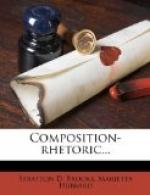+Theme L.+—Write a theme of three or more paragraphs, stating causes and effects.
Suggested subjects:—
1. Why hospitals are
necessary.
2. Why cigarette smoking
is dangerous.
3. Why girls should take
music lessons.
4. The effect of climate
upon health.
5. The effect of rainfall
upon the productivity and industries of a
country.
6. The effect of mountains,
lakes, or rivers upon exploration and
travel.
7. What connection is
there between occupation and height above the
sea
level, and why?
8. Why our city is located
where it is.
9. Why I came late to
school.
+93. Combination of Methods of Development.+—Frequently the presentation of our thought is made most effective by using some combination of the methods of development discussed in this chapter. Time and place are often interwoven, comparisons and contrasts flash into mind, general statements need specific illustration, or results demand immediate explanation—all in the same theme. Sometimes the order of coherence will be in doubt, for cause and effect demand a different order of statement from that which would be given were we to follow either time-order or position in space. In such cases we must choose whether it is most important to tell first why or when or where. The only rule that can be suggested is to do that which will make our meaning most clear, because it is for the sake of the clear presentation of our thought that we seek unity, coherence, and emphasis.
+Theme LI.+—Write a theme of several paragraphs. Use any method of development or any combination of methods.
(Choose your own subject. After the theme is written make a list of all the questions you should ask yourself about it. Correct the theme with reference to each point in your list of questions.)
SUMMARY
1. General principles of composition.
a. Unity.
b. Coherence.
c. Emphasis.
(1)
By position.
(2)
By proportion of parts.
2. An outline assists in securing unity, coherence, and emphasis.
3. Methods of composition development: A
composition may be developed—
a. With reference to
time-order.
b. With reference to
position in space.
c. By use of comparison
and contrast.
d. By stating generalization
and facts.
e. By stating cause
and effect.
f. By any suitable
combination of the above methods.
4. Transition and summary paragraphs may occur in compositions.




